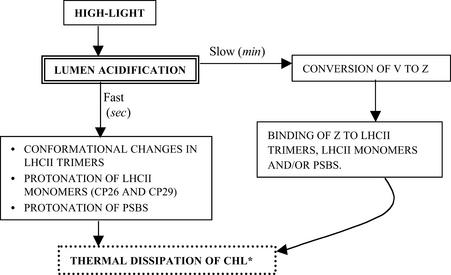Figure 1.
Model of Thermal Dissipation in Vascular Plants and Green Alga.
High light results in lumen acidification, which in turn stimulates changes in the antenna of PSII that promote thermal dissipation. The exact nature of these changes has not been defined, but they may include conformational changes in LHCII trimers, protonation of and conformational changes in the LHCII monomers and/or minor antenna (CP26, CP29, etc.), and/or protonation of and conformational changes in PsbS. These complexes all have been implicated as sites of thermal dissipation. The acidification also stimulates the deepoxidation of V to Z. Z acts either “directly” (by accepting excitation energy from Chl* and dissipating it as heat) or “indirectly” (by altering antenna conformation) to further increase the rate of thermal dissipation. (Figure courtesy of Dafna Elrad.)

